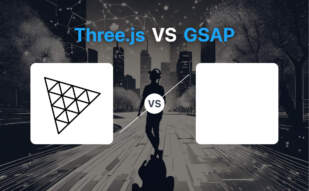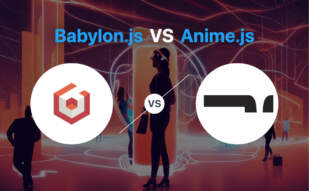GSAP (GreenSock Animation Platform) is a JavaScript toolset renowned for enabling high-performance animations in various web browsers, offering reliability with advanced sequencing capabilities. It boasts a ScrollTrigger plugin for creating scroll-based animations efficiently, with a core functionality that manipulates properties at high speed.
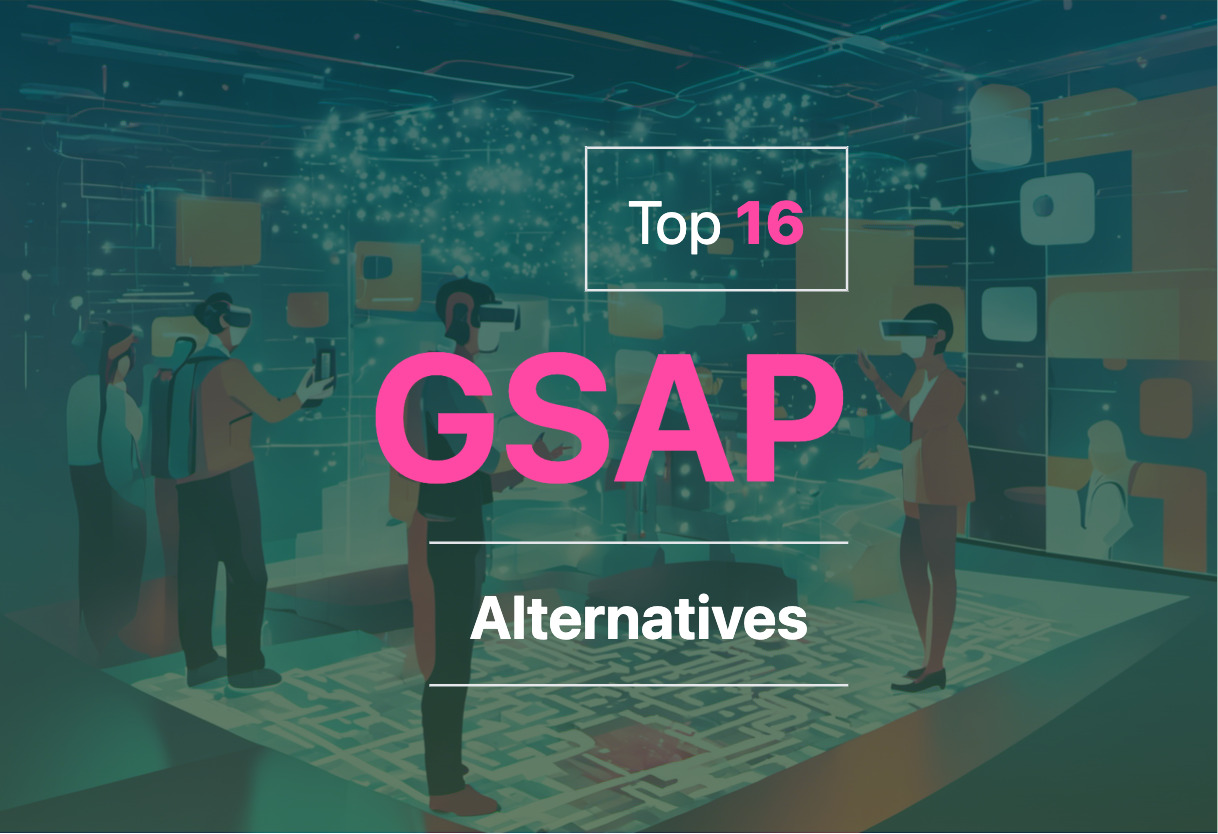
For those in search of alternatives to GSAP, choices encompass Anime.js, Framer Motion, Phaser, React Three Fiber, Three.js, Babylon.js, p5.js, Pixi.js, VTK.js, Canvas, Deck.gl, D3.js, Spline, WebGL, Unity3D, and Godot.
Anime.js
Emerging from France in the graceful year of 2010, Anime.js has indeed lived up to its name, derived from the French expression for “animated”. A distinguished denizen in the realm of web graphics technologies, this lightweight JavaScript library weaves magic into your projects, while its power costs you nothing.
Top Features of Anime.js
- This library cloaks in its repertoire a potent API that interfaces flawlessly with DOM, CSS, JavaScript objects, thus enabling you to command the three pillars of web development.
- Installation is a breeze with options for direct downloads and CDN links.
- Numerous properties for animation control like duration, delay, direction, loop, and autoplay are at your disposal.
- Anime.js allows you to animate HTML tags, class, or id elements, enriching your creative control.
- The capability to run concurrent animations, handle variable frame rates, and create animation keyframes make Anime.js a cherished tool among animators and developers.
| Availability | Entirely free, offering API access. |
| Launch Year | An illustrious decade since its birth in 2010. |
| Latest Update | Continued evolution, with the most recent update in October 2020. |
Limitations of Anime.js
- While a potent tool, Anime.js does not fully support playing animations “backwards”.
- Critique of this technology points to high CPU usage when not actively interacting.
- For more advanced animations, you might have to build your own library.
Anime.js Pricing
The magic of Anime.js can be summoned free of cost. Let not the power of your animations be restrained by price.
Anime.js Use Cases
Use Case 1: Individuals
For individuals seeking an introduction to animation frameworks, Anime.js’ ease of use and host of basic animation capabilities make it a stepping stone to turning ideas into interactive realities.
Use Case 2: Animators & Developers
The rich features, wide range of animation controls, APIs, and concurrent running of animations provide a robust foundation for animators and developers to create immersive experiences.
Use Case 3: React Programs
Consider alternatives like Framer Motion or Motion One, particularly for React programs, as the comfort and technical efficiency of Anime.js may be enhanced by these contemporaries.
Framer Motion

Framer Motion is an innovative animation library for React, purposely built to create powerful and direct animations with ease. If you’re all about unique style, increased user engagement and improved functionality, this motion marvel is your ticket to tech’s next level journey.
Framer Motion – The Best Features
- Core feature: motion component, bringing life to your designs with the magical animate prop.
- Exciting gesture recognition capability including hover, tap, pan, and drag for more interactive UX/UI.
- Ability to animate entire sub-trees of components with Variants – coding innovation at its finest.
- With scroll-triggered animations, storytelling is a breezy scroll away.
- MotionValues track animation states and velocities, thriving outside React’s render lifecycle for more fluid animations.
| Manual Animations | Trigger your animations manually using the robust useAnimate hook. |
| Layout changes | Framer Motion takes care of animating your layout changes, promising a seamless user experience. |
| Gesture functionalities | Take user experience to soaring new heights with the support for mobile and desktop interactions. |
The Downsides of Framer Motion
Critically consider that React 18 or higher is required for installation. Make sure this fits with your tech stack requirements before jumping on the Framer Motion bandwagon.
The Rad Reality of Framer Motion
Alert! *There’s no pricing to worry about*. Framer Motion is free, granting you the freedom of creation without pesky financial considerations.
Use Cases for Framer Motion
Use Case 1: Sleek Animations for React Developers
If you’re a React developer, Framer Motion is your new best buddy. It offers unique animation features, such as pathLength for SVG, for that visually stunning impact your applications deserve.
Use Case 2: Cleaner and Flexible Code
With Framer Motion’s innovative extracted animation definitions into Variants, your code is cleaner, more nimble and amazingly orchestrable.
Use Case 3: Smooth Exit Animations
The AnimatePresence feature grants you the power to implement exit animations smoothly, enhancing usability and style in your apps.
Deck.gl
Your roadmap to large-scale data visualization begins with Deck.gl – a supremely efficient tool powered by WebGL2.
Deck.gl Top Features
- High-performance rendering: Capable of handling and updating large volumes of data.
- Flexible Framework: Compose visual layers from JSON data including icons, polygons, and text.
- Interactive event handling: Features picking, highlighting, and filtering capabilities.
- Cartographic projections: Seamlessly integrates with all major basemap providers for impactful visualizations.
- Extensive customization: Dec.gl offers flexible API sets and extendable core classes.
- Wide usage modes: Script Tag, NPM Module, Pure JS, React, Python facilitate diverse application.
| Third-Party Integration | Learning Tools |
|---|---|
| deckgl-typings, mapdeck, vega-deck.gl, etc. | API docs, demos, Codepen, Observable, etc. |
| earthengine-layers, deck.gl-native, deck.gl-raster | Medium blog posts, a dedicated Slack workspace |
Deck.gl Downsides
- An initial learning curve may be experienced due to the complex nature of some features.
- Data sources need to be accurate and abundant for the best visualizations.
Deck.gl Pricing
Being a part of the OpenJS Foundation, Deck.gl operates on an open-source model, hence it’s free to use.
Deck.gl Use Cases
Use case 1: Data Scientists
For data scientists grappling with substantial amounts of data. Deck.gl eases the process by simplifying the visualization of large datasets.
Use case 2: Geographers
Geographers can leverage the cartographic projections feature to enhance their visualizations.
Use case 3: Developers
Developers can make the most of the wide usage modes to mesh the tool with their preferred tech stack effectively.
D3.js
Welcome to the fabulous world of D3.js, the brainchild of cohorts Mike Bostock, Jason Davies, and Jeff Heer, Vadim Ogievetsky. Its glamorous full name is Data-Driven Documents and it’s here to add a sprinkle of interactivity and a whole lotta fun to your data visualizations in web browsers!
Top Features of D3.js
- Data Binding: D3 facilitates magic tricks where your loaded data can drive the creation of HTML elements. Presto!
- Stunning Transitions: What’s life without a little transition? With D3’s transition capabilities, watch your figures smoothly morph from one form to another. Pure artistry!
- SVG Graphics: Create visuals that adhere steadfastly to your data, thanks to D3’s SVG generation capabilities. No more “chart liberty”, facts only here folks!
| Feature | Description |
| Format Flexibility | Gobbles up data in a wide variety of formats such as JSON, CSV, and geoJSON – making D3.js a true culinary connoisseur. |
| Web Standards | Operates directly on web standards. reaps the benefits of using external stylesheets for altering appearances and employing debuggers for, well, debugging. |
D3.js Disadvantages
- As much as it is loved by media organizations, D3.js might be a slight overkill for private dashboards or one-off analyses.
- It’s a Low-level approach, which requires substantial control and involvement. Not for those who prefer a ‘set-and-forget’ style!
D3.js Pricing
Oh, did we mention it’s FREE? Yes, D3.js is an open-source tool that is as free as the summer breeze!
D3.js Use Cases
Use Case 1: Media Organizations
D3.js is a rockstar when it comes to media organizations. With its ability to create dynamic, interactive visualizations, it’s the perfect match for storytelling through data in an engaging and interactive manner.
Use Case 2: Academia
Knowledge is power, and what better way to wield that power than with stunning visualizations? Academics and scholars can use D3.js to bring their data to life in a captivating and comprehensible way.
Use Case 3: Data Visualization Practitioners
For the wizards who dance with data daily, D3.js can help create expressive and flexible graphics that don’t just tell, but show, tell and engage with the data story.
Spline
Introducing Spline, a 3D design tool that combines ease, interactivity, and supreme functionality. It harnesses the power of WebGL, requiring no built-in player, and offers an immersive, codeless designing experience.
Spline Top Features
- Intuitive user interface for building 3D experiences from scratch or using pre-made objects.
- Colossal collaboration features including synchronous fine-tuning and commenting.
- Exports designs as image files, GIFs or code-embedded web pages.
- Exclusive integration with popular platforms like Notion, Webflow.
- Interactivity-rich platform with tools for editing materials and adding 3D objects.
| Feature | Description |
|---|---|
| AI-style transfer and AI texture tools | Delivers ease in content creation and contributes to shrinking friction in 3D process. |
| Desktop App | Allows creation, editing, and saving of projects. |
| Compatibility | Supports a variety of platforms including Mac, Window, Linux. |
Spline Limitations
- Competes with long-standing 3D tools like Blender, Cinema 4D.
- Limited to browser and desktop applications.
- Brand logo removal and creation of personal folders comes at a price.
Spline Pricing
Freemium model with plans starting from $9/month/user for advanced features. Team plan designed for comprehensive access at $12/month/user.
Spline Use Cases
Use case 1: Enhancing User Experience
Spline’s 3D creations can be displayed on websites, boosting interactivity and enriching customer experience.
Use case 2: Website Designers
With its simple UI and advanced features, Spline becomes a go-to tool for website designers.
Use case 3: Content Creators
Spline’s ability to create interactive 3D designs makes it an excellent tool for dynamic content creation.
WebGL
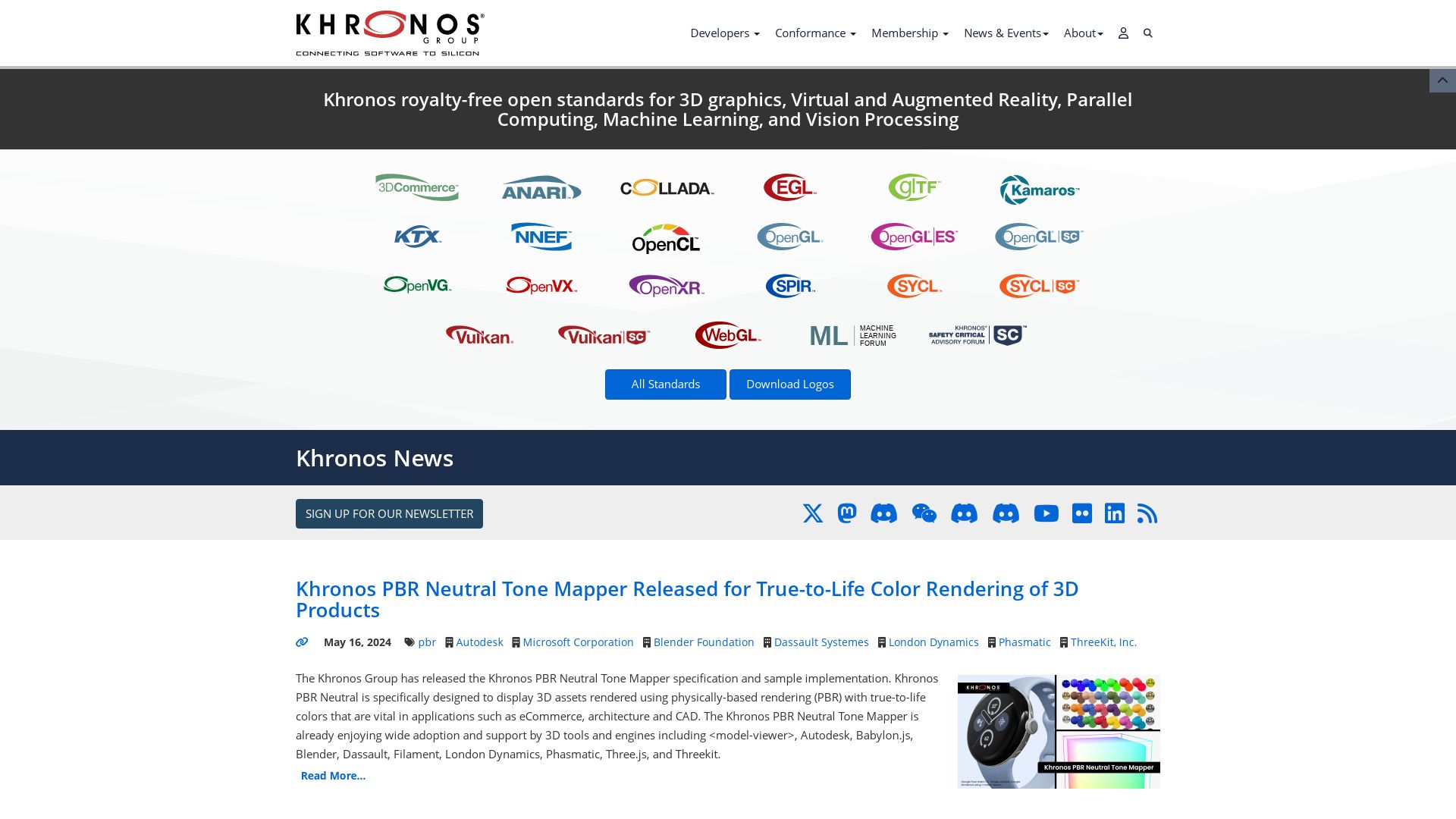
An impactful player in the web graphics sphere, WebGL is a low-level 3D graphics API, engineered on the foundation of OpenGL ES, and bridged to ECMAScript through HTML5 Canvas. It offers the privilege of painting 3D on the web without the need for plugins, blessing it with seamless browser integration.
WebGL Top Features
- Choreographed compatibility with major browsers namely Apple, Google, Microsoft, and Mozilla.
- Offers cross-platform compatibility, impressive GPU 3D acceleration, and native GLSL support.
- Carries the torch of being the web standard for mobile, extending support to iOS Safari, Android Browser, and Chrome for Android.
- Comes bundled with a DOM interface integration, strengthening direct interactions with HTML Document elements.
- It’s an open-source software, running without a JVM, controlled by the web browser.
| Feature | Description |
|---|---|
| 3D Graphics Support | With HTML 5’s release, WebGL fortified itself with features needed to support 3D graphics. |
| Accessible | With JavaScript’s automatic memory management, and elimination of compilation need, WebGL applications are developer-friendly. |
WebGL Limitations
- WebGL inherits a fundamental weakness: it operates on OpenGL which runs relatively slower and doesn’t match DirectX’s comprehensibility.
- The quality issues with OpenGL steered most games towards Windows-targeted D3D10+.
- Current Windows web browsers operate on D3D11 and not OpenGL, although they accept WebGL APIs.
WebGL Use Cases
Interactive 3D Graphic Applications
With its inception in an era void of Flash, WebGL ushered as a celebrated technology for online, interactive 3D graphics, paving the path towards visual grandeur in web applications.
Game Development VR
When targeting Windows-intensive platforms, WebGL plays well with D3D10+, thus assisting developers in rolling out engaging gaming experiences.
Mobile-Friendly 3D Content
Being the standard for 3D web graphics on mobile platforms, WebGL enables rich, animated and interactive content on mobile browsers, providing a consistent user experience across devices.
Unity3D
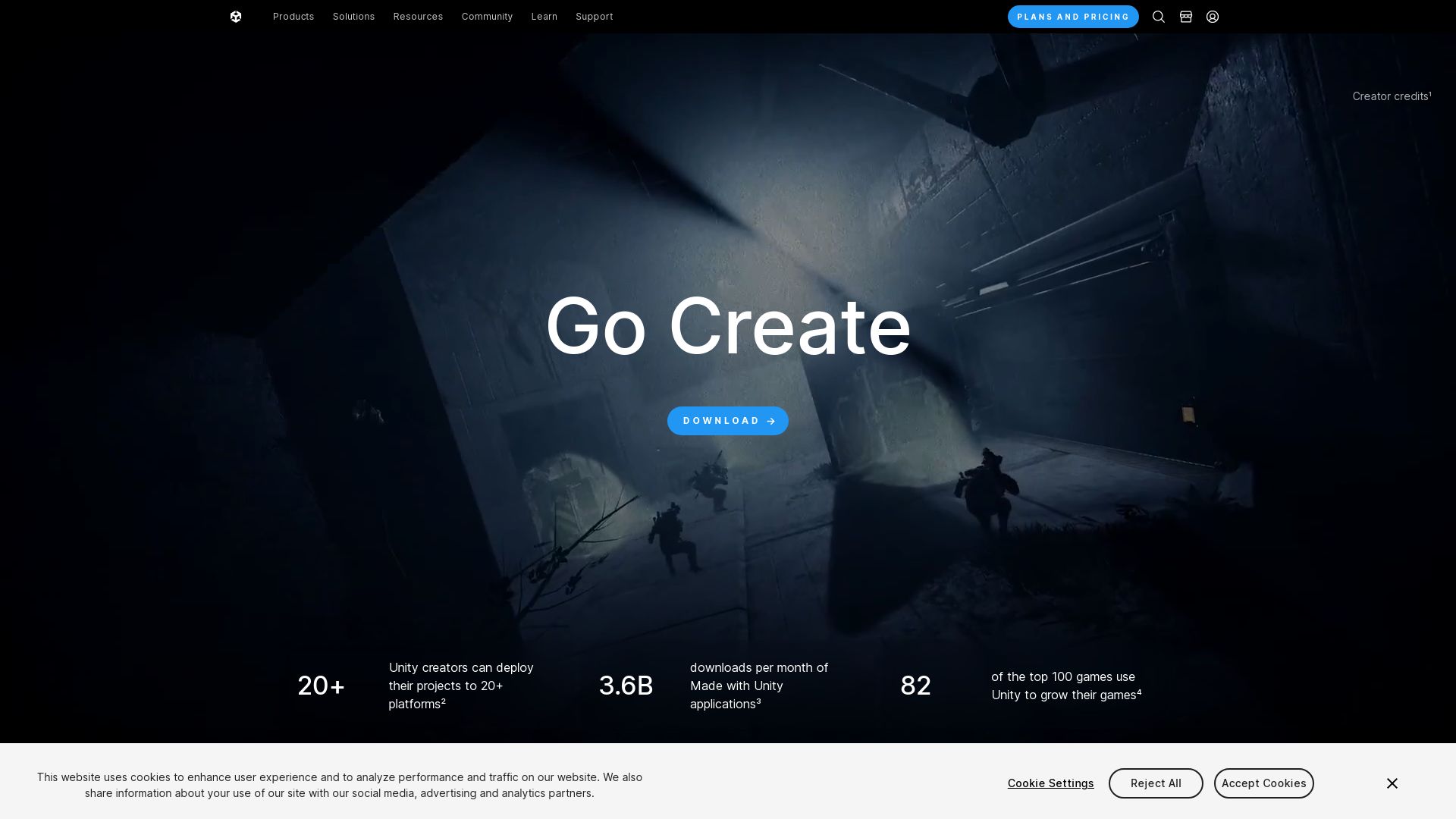
Born in the halls of Apple’s Worldwide Developers Conference in 2005, Unity3D rode the crest of a wave that would change gaming forever. Developed by Unity Technologies, it emerged as a robust cross-platform game engine that would not just transform game development, but expand its reach to industries as diverse as film, automotive and architecture, and even the U.S. Armed Forces.
Unity3D Top Features
- Comprehensive cross-platform support, ranging from various desktop, mobile, console, to virtual reality platforms.
- A powerful 2D and 3D game creation engine. For 2D physics, the widely used Box2D engine is incorporated.
- Integration with Visual Studio, C# scripting API, JavaScript scripting language and the Mono Develop IDE.
- Extensive cross-platform release function which offers API for custom-made scripting tools.
- Availability of a rich library of scripts, models, materials, and other items on the Unity marketplace.
| Year of Release | Version | Remarkable Features |
|---|---|---|
| 2007 | Unity 2.0 | Brought prowess and versatility at a time when digital gaming was taking baby steps |
| 2010 | Unity 3.0 | Brought new tools and improvements, making it popular among developers |
| 2015 | Unity 5.0 | First to feature cross-platform support, revolutionizing the gaming industry |
Unity3D Limitations
- Fluctuating pricing policy and political changes led to community backlash.
- Faces stiff competition from others like Unreal, Godot, etc.
- Business model undergoing constant changes, making its future uncertain.
Unity3D Pricing
Unity3D has plans and pricing for students, personal use, and enterprises, that vary with financial parameters like the user’s revenue thresholds. The prices for different versions even range up to $1500. Starting from 2024, a ‘Per Install’ fee will apply, based on game installs.
Unity3D Use Cases
Use Case 1: Game Development
With its easy-to-use interface, Unity3D is highly popular among both indie and mobile game developers, more so for iOS and Android, giving them the ability to create immersive experiences for players.
Use Case 2: Non-gaming Industries
Industries outside of gaming like film, automotive, architecture, engineering, and construction, and even the U.S Armed Forces, have adopted Unity3D for their hi-tech projects due to its versatility.
Use Case 3: Education
With its student-friendly plans and a rich set of features, Unity3D has found a strong foothold in educational institutions, providing students a hands-on experience in game and software development.
Godot
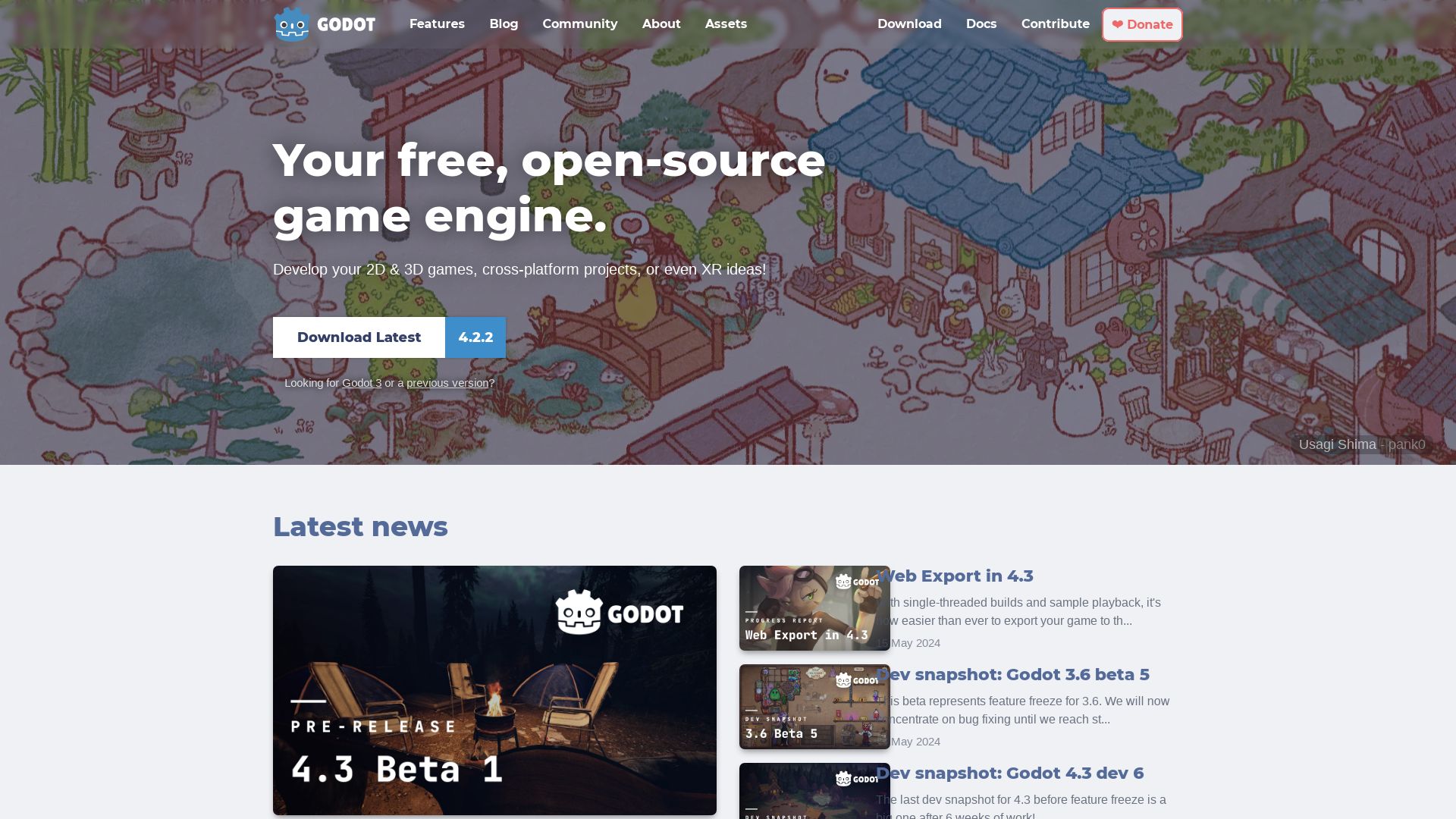
Godot is an open-source game engine cherished by developers globally. Renowned for its highly intuitive scene-driven design, it fosters creativity by allowing game creation from simple blocks.
Godot Top Features
- Open-source engine: Free under MIT license, with modifiable codebase and regularly updated.
- Scene-driven design: Nodes allow for complex, reusable scenes combined into full-featured components.
- Multi-platform support: Operates on platforms including Windows, macOS, Linux, and Android.
- Built-in scripting languages: Features GDscript and supports C# for .NET and C++ via GDExtension API.
- Specialized 2D workflow: Provides an ideal environment for both games and apps.
- Community language support: Includes bindings for languages like Rust, Nim, Python.
| Visual Editor | Godot includes an inherent visual editor for coding. |
| 3D Engine Support | Can support both high and low-end devices, with direct import of Blender files. |
| Storage Solution | Designed for efficient team collaboration. |
Godot Limitations
- Limited to desktop platforms for .NET availability in Godot 4.
- Complex 3D game development may not be ideal.
Godot Pricing
Godot offers a compelling financial argument. It’s free, under the MIT license. This means it comes with no contracts, hidden fees, or licensing costs.
Godot Use Cases
Use Case 1 – Indie Game Developers
For indie game developers seeking a cost-effective and resource-light engine, Godot provides an ideal solution with its user-friendly 2D workflow.
Use Case 2 – Collaborative Project Teams
Project teams benefit from Godot’s storage solution designed for team collaboration. It makes it easier to track and merge changes.
Use Case 3 – Learners & Beginners
For learners and beginners, Godot’s intuitive scene-driven design and built-in scripting language GDscript makes game creation easy to grasp, while still providing room for growth.
Phaser
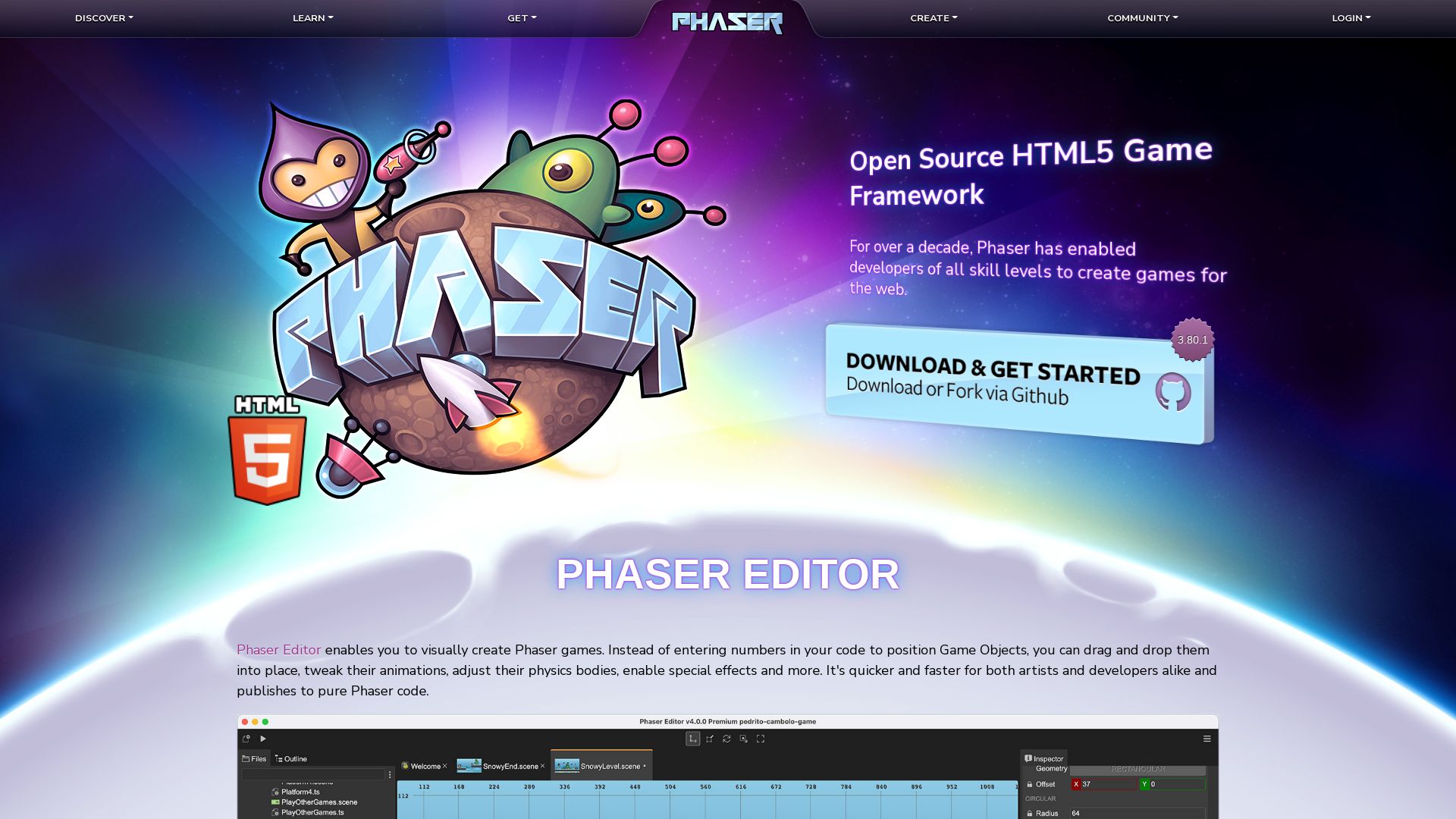
Embark on your game development journey with Phaser—a 2D game framework that disregards platform boundaries. Born out of the brilliant mind of Richard Davey, Phaser has been a heavyweight in the HTML5 gaming scene since its initial release in April 2013.
Phaser Top Features
- Pixel-Perfect Rendering: Phaser harnesses the potential of Canvas and WebGL renderers, auto-switching based on the browser’s cape.
- Cross-Platform: Got a killer game idea? Deploy it to iOS, Android and native desktop apps with nifty tools like Apache Cordova and PhoneGap.
- Evolutionary Versions: Phaser has stood the test of time, with Classy Phaser 1, Revolutionary Phaser 2, and the ongoing work on Phaser 3 and Phaser 4. Each Phaser edition offers a fresher, bolder take on game development.
- Audio Capabilities: Phaser understands the power of sound to enhance player immersion. So it allows Web & HTML5 audio for old school and contemporary sound playbacks.
| Feature | Perks |
|---|---|
| Multiple Physics Systems | Your games can embrace variety with Arcade Physics, Ninja Physics, P2.JS. Physics in Phaser isn’t boring! |
| Game Creation Process | Making a game feels like playing one. Preload() brings all your declared assets to the game creation table. Add scene, include function create for aesthetic elements, and you’re already halfway there! |
Phaser Downsides
- TypeScript Rewrite: Transitioning from Phaser version 3 to 4 might summon minor compatibility issues due to the TypeScript rewrite.
Phaser Pricing
Get ready to break the bank with…nothing! Phaser is 100% free and open-source. That’s right; barriers don’t exist in the Phaser game development universe.
Phaser Use Cases
Use Case 1: Indie Developers
Phaser is the trail blazed by indie developers. Phaser’s flexibility and active support community eliminate obstacles and reduce learning curves for developers without deep pockets.
Use Case 2: Educational Platforms
Educational platforms can leverage Phaser’s framework to create engaging games, turning learning into a fascinating journey.
Use Case 3: Professional Game Developers
For professional game developers, Phaser comes as a boon that offers room for creativity while adhering to industry standards.
React Three Fiber
As a cutting-edge design tool in the realm of web-based graphics, React Three Fiber offers a viable and effective solution for constructing dynamic 3D scene graphs. This innovative React renderer for three.js eschews traditional methods and empowers creators to script detailed and interactive scene graphs in a declarative and reusable manner.
Top Features of React Three Fiber
- Declarative and self-contained graphics components
- Responsive to state and readily interactive
- Superb performance, with no overhead for React components
- Full compatibility with all of Three.js features
- Regular feature updates to stay in sync with Three.js innovations
- Potent ‘useFrame’ and ‘useState’ tools for improved control of the render loop
- A rich ecosystem consisting of utility libraries such as @react-three/drei, @react-three/gltfjsx, @react-three/postprocessing
| Feature | Benefit |
|---|---|
| Declarative Components | Significantly simplifies scene graph construction |
| Interaction-friendly | Enables dynamic, state-responsive graphics |
| Full Three.js Compatibility | Unfettered access to all Three.js features |
Limitations of React Three Fiber
Despite its numerous capabilities, React Three Fiber does not impose any notable limitations on developers.
React Three Fiber Pricing
Worried about cost? Fear no longer. React Three Fiber is an open-source gem, available freely for those looking to enrich their programming toolbox.
React Three Fiber Use Cases
Use case 1: Realistic Physics Simulation
React Three Fiber’s engine empowers developers to create truly immersive and realistic physics simulations, crucial in many modern digital applications.
Use case 2: Interactive 3D GUIs
In the realm of user interface design, React Three Fiber offers the unique ability to spin up intuitive 3D GUI controls within a browser environment.
Use case 3: Dynamic Object Manipulation
Illustrate your creativity with React Three Fiber by developing interactive and responsive objects capable of changing appearance based on user input.
Three.js
Launched to global acclaim by author Ricardo Cabello in April 2010, Three.js is a powerful JavaScript library engineered for creating and animating 3D computer graphics right in your web browser.
Three.js Top Features
- WebGL Integration: Natively uses WebGL to render high-fidelity 3D scenes with GPU acceleration, thereby eliminating the need for browser plugins.
- Extensive Tools: From scenes, cameras, animations, materials, shaders, to objects and geometry, Three.js offers a vast suite of features for realizing your creative vision.
- WebXR Support: Pioneer in the realm of digital realities, Three.js comes with inbuilt support for creating Virtual and Augmented Reality experiences.
- Cross-Browser Compatibility: Ensures seamless operation across all browsers that support WebGL 1.0.
| Initial Release | April 24, 2010 |
| Repository | Three.js on GitHub |
| Contributors | A cohesive global community of over 1700 Github contributors |
Three.js Limitations
- Learning Curve: As with any comprehensive toolkit, Three.js may come with a steep learning curve for beginners.
- WebGL Dependent: Requires the browser to support WebGL 1.0. Without this, the use of Three.js becomes limited.
Three.js Pricing
Three.js stands as a beacon of digital inclusivity, offering its entire set of advanced 3D web graphic tools free of charge. Covered by the flexible and permissive MIT License, it invites developers around the world to create, share, and innovate on its open-source platform.
Three.js Use Cases
Use case 1: Web-Based 3D Modelling
Three.js excels in the realm of web-based 3D modelling with its robust suite of tools. Developers can create complex animations effortlessly.
Use case 2: Virtual Reality Experiences
With innate WebXR support, Three.js enables developers to pioneer immersive Virtual and Augmented Reality experiences accessible via browsers.
Use case 3: Graphics-Intensive Web Applications
Whether it’s a game or a data visualization tool, Three.js delivers the power to create visually arresting, graphics-intensive web applications.
Babylon.js
Meet Babylon.js, the in-browser 3D engine that’s debating the rules of web graphics technologies. Conceived by David Catuhe and nurtured by Microsoft and a team of well over 190 contributors, it has taken over the World Wide Web since its launch in 2013. Babylon.js utilizes real-time 3D graphics via HTML5, delivering a knockout visualization experience right in your web browser.
Babylon.js Top Features
- Authentic 3D modeling: Its durable polygon modeling system with triangular faces and limited use of constructive solid geometry makes for an unparalleled 3D modeling process.
- Physically based rendering and post-processing technologies: Babylon.js strikes with photo-realistic images that defy skepticism.
- Open source: With GitHub source code available, and distributed under an Apache License 2.0, it fosters an environment of collaborative growth.
- Integration with physics engines: The use of plugins like Cannon.js and Oimo simulate collisions and real-world physical reactions in a chillingly accurate manner.
| Rendering Element | Use |
|---|---|
| HTML5 canvas element | Strategically sets rendered pixel positions and colors as defined by the shader program. |
| API | Accessible for integrating Babylon.js with your unique projects. |
Babylon.js Limitations
- Documentation: Babylon.js, while powerful, struggles with comprehensive user-friendly documentation and tutorials for beginners.
- Heavy-weight: Babylon.js can be large in size leading to increased load times.
- Browser compatibility: The 3D engine and user code interpreted by HTML5 and WebGL supporting browsers, which could limit cross-browser compatibility.
Babylon.js Pricing
Babylon.js is entirely free and open-source, providing a world-class tool for creating jaw-dropping web graphics without digging into your wallet.
Babylon.js Use Cases
Use case 1
Babylon.js excels in the creation of virtual worlds, providing a real-time, interactive and visually fruitful platform for game development.
Use case 2
In the world of education in medicine, the vivid 3D visuals of Babylon.js can aid in comprehending complex medical procedures and anatomical structures.
Use case 3
Military training comes alive with Babylon.js’s powerful simulation capabilities, enabling soldiers to prepare for possible situations in a safer environment.
p5.js
Navigating the digital realm, we often encounter an intersection of art and technology. Stepping into this crossroads, we come across p5.js, a graphics library that mirrors the beauty of the visual world in the language of code, initiated by Casey Reas and Ben Fry at the MIT Media Lab in 2001. Known for its graphical user interface and their role as a precursor to Arduino and Wiring, p5.js stands as a tribute to the continuous evolution of digital interaction.
p5.js Top Features
- Intuitive Visual Context: As a graphics library, p5.js provides an engaging visual context, making it an ideal tool for teaching non-programmers about computer programming.
- IDE Sketchbook: The p5.js’ integrated development environment uniquely blends the artistic with the technical, allowing for the creation of international projects.
- Award-winning: The design-centric approach of p5.js has won recognitions such as the 2005 Golden Nica award and the 2011 National Design Award.
| Key Feature | Impact |
|---|---|
| User-Class Creation | Flexibility in PApplet sketch without standard data type limitations. |
| P5Py and Processing.py | Python iterations, ideal for simulation and interactive art creation. |
| Relevant to Arduino and Wiring Projects | Fruitful for those interested in prototyping and actualizing products. |
p5.js Limitations
- No encouragement of static variables or methods.
- Dependence on Java for its Processing IDE and Processing libraries, which may not appeal to non-Java programmers.
- Discontinuation of its JavaScript port, Processing.js, in 2018.
p5.js Pricing
As a manifestation of tech accessibility, p5.js comes with a zero-cost advantage – making it a genuinely open source tool, licensed under GPL and LGPL.
p5.js Use Cases
Use case 1: Education
p5.js becomes an effective tool for teaching coding and computational thinking. Its visually-based context makes it ideal for non-programmers and students alike.
Use case 2: Visual Artists and Designers
p5.js serves visual artists and designers, enabling them to create interactive and visually-stimulating works of software art.
Use case 3: Mobile Processing
p5.js, in a joint effort with Android and Mobile Processing, allows the Processing software to run on Java-powered mobile devices.
Pixi.js
Step into the dynamic world of Pixi.js, a premier WebGL or Canvas 2D rendering system. A darling of creators and developers alike, Pixi.js finds its forte in fabricating complex web-based graphics including games, educational content, interactive ads, and data visualizations.
Top Features of Pixi.js
- Optimized for Speed: A well-tuned render pipeline that prioritizes maximum performance
- Extensible: With a clean internal API and a JavaScript base, Pixi.js allows flexibility in design and development
- Advanced Rendering: Beyond simple images using its SimpleRope, and Graphics for polygons, lines and more.
- Easy Deployment: Harness the power of the same basic requirements as a website- JavaScript, images, and audio.
| WebGL Native: | Pixi.js boasts of faster rendering and advanced visuals through its Filters class, outperforming DOM/Canvas APIs. |
| Cross-Platform Compatibility: | Automatic switching between WebGL and Canvas as needed for smooth platform transitions. |
| Open-Source: | Get full access to the source code on GitHub. |
Pixi.js Disadvantages
Despite its many upsides, users should remember that Pixi.js isn’t a dedicated game engine. It excels at efficienct screen movements but might fall short on more complex game functionalities.
Pixi.js Pricing
One of the primary advantages, Pixi.js is completely open-source and free. You can contribute financially to accelerate feature development and improve documentation.
Pixi.js Use Cases
Use Case 1: Interactive ads
With Pixi.js, designers can create visually appealing and interactive ads, leveraging the power of its advanced rendering. It optimizes performances, offering maximum visual impact for users.
Use Case 2: Online Games
Although not a game engine, Pixi.js provides the speed and optimized rendering desired for creating sleek, fast-loading online games.
Use Case 3: Data Visualization
Data scientists and analysts alike will appreciate the clear and efficient data visualization possibilities of Pixi.js, enabling comprehensive insight delivery.
VTK.js
An open-source solution on the cutting edge of virtual technology, VTK.js unites 3D computer graphics, image processing, and visualization. Beautifully adapted into an ES6 class library for smooth web application integration, it consistently strives for progress, with WebGPU support on the horizon.
VTK.js Top Features
- Powered by WebGL, promising upcoming WebGPU support.
- Offers ImageData and PolyData rendering, pipeline infrastructure, and popular readers.
- Ambitiously rewrites VTK/C++ into pure JavaScript (ES6).
- Provides infrastructure for pipelines and filters.
- Supports remote VTK/ParaView server connection for remote-rendering and synchronized C++/RenderWindow content.
- Employs a timestep-based animation handler for .vtkjs files.
- Boasts VR support, harnessing the OpenVR standard, with applications in scientific and medical data visualization.
| Additional Feature | Description |
|---|---|
| VTK.js v24 release | Offers ES Module build, order-independent transparency for geometry, ScalarBarActor, CubeAxesActor, WebXR rendering. |
| ITK bridge upgrade | Furnished with new itk-wasm interop code ensuring seamless back-end operations. |
| WebGPU support | Continuous improvements to ensure future-ready Web support. |
VTK.js Limitations
- Does not aim to cover all filters in VTK/C++.
- WebAssembly files from ITK WebAssembly could potentially increase downloading time.
VTK.js Pricing
As an open-source technology, VTK.js prioritizes accessibility and innovation over profit. Thanks to the shared efforts of its brilliant coding community, VTK.js can be leveraged free of charge.
VTK.js Use Cases
Use Case 1: 3D Graphics Rendering
VTK.js’s sophisticated 3D graphics processing functionality makes it an ideal choice for web developers needing a robust graphics rendering engine.
Use Case 2: Scientific Visualization
With its state-of-the-art visualization algorithms, scientists can leverage VTK.js to bring complex data to life.
Use Case 3: Medical Data Visualization
Medical professionals can transform DICOM files into high-resolution 3D renderings with VTK.js, aiding in diagnostics and patient education.
Canvas

The HTML5 <canvas> element is a dynamic way of creating graphics on-the-fly, typically via JavaScript. It is an adaptable platform allowing for intentions ranging from basic shapes to complex interactive applications and animations.
Canvas Top Features
- Dynamic Graphics Creation: Canvas allows you to draw paths, boxes, circles, text, and images dynamically to create innovative graphics.
- Versatility: With the ability to have multiple <canvas> elements on one page, this tool provides flexibility in design and interactive content creation.
- Comprehensive Drawing Options: Its features extend to drawing rectangles, paths, lines, and Bezier curves, using images, creating gradients, applying styles and colors, drawing text with different fonts, drawing patterns and shadows, and much more.
- Direct Pixel Manipulation: The HTML5 Canvas API allows you to create “raster” graphics and to manipulate objects at a pixel level, giving you control over every detail.
| Features | Description |
| Drawing Styles | Ability to enhance graphics quality by applying different styles like lineWidth, lineCap, lineJoin, and miterLimit, among others. |
| CanvasGradient Objects | Enables creation of linear and radial gradients, enriching the visual experience. |
| CanvasImageSource | Allows you to draw images directly to canvas using various types of image sources. |
Canvas Limitations
- IE8 Compatibility: For users on older browsers like IE8, support for <canvas> is only available with the ExplorerCanvas script.
- Dependent on Script: While Canvas houses graphics, actual graphics need to be drawn with a script, this could be a limitation for those unfamiliar with scripting.
- RenderingContext Requirement: Initially, a rendering context is required to display anything, adding to the learning curve for new users.
Canvas Pricing
As an integral part of HTML5, the Canvas tool is completely free and open-source, making it accessible to everyone.
Canvas Use Cases
Use case 1: Web Designers
Web designers can take advantage of Canvas to dynamically create graphical data presentations, enhancing user engagement on their websites.
Use case 2: Game Developers
Game developers can use Canvas to design unique in-browser games by making use of the ability to animate graphics and manipulate objects at pixel level.
Use case 3: Educational Platforms
Catering to educational platforms, Canvas can be used to create interactive diagrams or simulations, adding to the functionality of e-learning resources.
Patrick Daugherty
Content writer @ Aircada. Merging AR expertise with a love for late-night gaming sessions.




